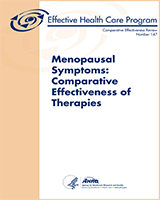Menopausal Symptoms: Comparative Effectiveness of Therapies
Comparative Effectiveness Reviews, No. 147
Authors
Investigators: Mark D Grant, MD, PhD, Anne Marbella, MS, Amy T Wang, MD, Elizabeth Pines, MS, Jessica Hoag, MPH, Claudia Bonnell, RN, MLS, Kathleen M Ziegler, PharmD, and Naomi Aronson, PhD.Affiliations
Structured Abstract
Objectives:
To systematically review and synthesize evidence evaluating the comparative effectiveness of treatments for menopausal symptoms, along with potential long-term benefits and harms of those treatments.
Data sources:
The following electronic databases were searched through January 2014: MEDLINE®, Embase®, Cochrane Controlled Trials Register, and AMED Allied and Complementary Medicine. Gray literature searches included clinicaltrials.gov, the Food and Drug Administration Web site, and relevant conference abstracts.
Review methods:
Menopausal symptom outcomes included: vasomotor, quality of life, psychological, sexual function, urogenital, and sleep disturbance. Randomized controlled trials provided the evidence base for symptom relief. Standardized mean differences were calculated to allow pooling of outcomes from varied measures. Network meta-analyses were performed when possible, along with pairwise comparisons. Systematic reviews, cohort studies, and case-control studies provided evidence for the following long-term benefits and harms: breast, colon, endometrial, and ovarian cancer; coronary heart disease and venous thromboembolic events; gallbladder disease; and osteoporotic fractures.
Results:
Evidence from 283 trials provided results for vasomotor symptoms (211 trials), quality of life (125 trials), psychological symptoms (108 trials), sexual function (94 trials), urogenital atrophy (71 trials), and sleep disturbance (56 trials). The most commonly studied agents were estrogens, isoflavones, and selective serotonin reuptake inhibitors/serotonin-norepinephrine reuptake inhibitors (SSRIs/SNRIs). Estrogens appeared to be the most effective treatment in relieving vasomotor symptoms and were accompanied by better quality-of-life scores. SSRIs/SNRIs relieve vasomotor symptoms less effectively than estrogens but were accompanied by the largest improvement in global measures of psychological well-being. Estrogens administered vaginally diminished pain during sex and testosterone increased sexual activity. Measures of urogenital atrophy were improved with ospemifene and vaginal or oral estrogens. Estrogens also improved sleep, but the effect appeared to be modest. Over the long term, estrogen combined with progestogen has both beneficial effects (fewer osteoporotic fractures) and harmful effects (increased risk of breast cancer, gallbladder disease, venous thromboembolic events, and stroke). Estrogens given alone do not appear to increase breast cancer risk, although endometrial cancer risk is increased. There is limited evidence on the long-term effects of most nonhormone treatments. No studies were identified that examined the efficacy or safety of compounding practices for hormone therapies.
Conclusions:
Women experiencing symptoms of menopause can consider a number of potential treatments of varying efficacy. From a large body of evidence, there is considerable certainty that estrogens are the most effective treatment for relieving vasomotor symptoms and are accompanied by the greatest improvement in quality-of-life measures. For other common symptoms—psychological, urogenital, and sleep disturbance—although estrogens are effective, some nonhormonal agents compare favorably. Estrogens are accompanied by potential long-term harms that require consideration. There is limited evidence on the potential consequences of long-term use of nonhormonal agents when those agents are used to treat menopausal symptoms.
Prepared for: Agency for Healthcare Research and Quality, U.S. Department of Health and Human Services1, Contract No. 290-2007-10058-I, Prepared by: Blue Cross and Blue Shield Association Technology Evaluation Center, Evidence-based Practice Center, Chicago, IL
Suggested citation:
Grant MD, Marbella A, Wang AT, Pines E, Hoag J, Bonnell C, Ziegler KM, Aronson N. Menopausal Symptoms: Comparative Effectiveness of Therapies. Comparative Effectiveness Review No. 147. (Prepared by Blue Cross and Blue Shield Association Technology Evaluation Center Evidence-based Practice Center under Contract No. 290-2007-10058-I.) AHRQ Publication No. 15-EHC005-EF. Rockville, MD: Agency for Healthcare Research and Quality; March 2015. www.effectivehealthcare.ahrq.gov/reports/final.cfm.
This report is based on research conducted by the Blue Cross and Blue Shield Association Technology Evaluation Center Evidence-based Practice Center (EPC) under contract to the Agency for Healthcare Research and Quality (AHRQ), Rockville, MD (Contract No. 290-2007-10058-I). The findings and conclusions in this document are those of the authors, who are responsible for its contents; the findings and conclusions do not necessarily represent the views of AHRQ. Therefore, no statement in this report should be construed as an official position of AHRQ or of the U.S. Department of Health and Human Services.
The information in this report is intended to help health care decisionmakers—patients and clinicians, health system leaders, and policymakers, among others—make well-informed decisions and thereby improve the quality of health care services. This report is not intended to be a substitute for the application of clinical judgment. Anyone who makes decisions concerning the provision of clinical care should consider this report in the same way as any medical reference and in conjunction with all other pertinent information, i.e., in the context of available resources and circumstances presented by individual patients.
AHRQ or U.S. Department of Health and Human Services endorsement of any derivative products that may be developed from this report, such as clinical practice guidelines, other quality enhancement tools, or reimbursement or coverage policies, may not be stated or implied.
This report may periodically be assessed for the currency of conclusions. If an assessment is done, the resulting surveillance report describing the methodology and findings will be found on the Effective Health Care Program Web site at www.effectivehealthcare.ahrq.gov. Search on the title of the report.
None of the investigators have any affiliations or financial involvement that conflicts with the material presented in this report.
- 1
540 Gaither Road, Rockville, MD 20850; www
.ahrq.gov
